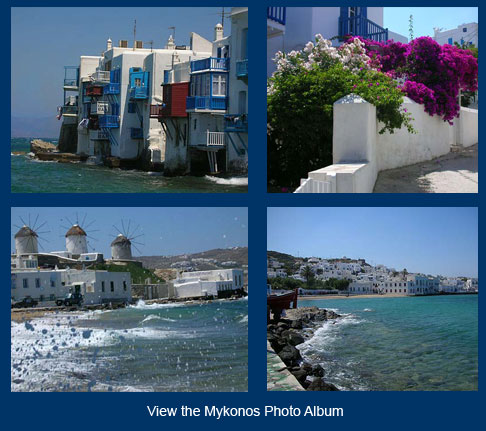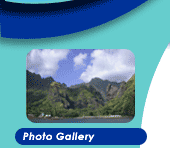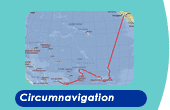June 4 – June 19, 2008
Porto Rafti, Greece
Island Hopping across the Aegean from Turkey to Greece
by Lois Joy
This was the passage where we discovered the fickle winds of the Mediterranean, and that sailing this part of the world is not for wimps after all. How we long for those dependable trade winds of the Atlantic, Pacific and Indian Oceans! How nice it was to set the sails and to sail on for hundreds of miles without changing them. Here in the Med, one never knows for sure from what direction the wind will come, when it will change, or whether there will be any wind at all. When sailing to the next destination, the best guess is that it will be “on the nose” no matter which route one plans to take and what the forecast is (or was). No wonder that Homer could write such tales of the adventures of Odysseus sailing this vast sea!
June 4th and 5th Cesme, Turkey: My sister is coming!
“My sister is coming, my sister is coming.” Now after my sister Ret has flown back to Texas, it is time for Gunter to say these words. Helga arrives in the afternoon via taxi from Izmir Airport, after a short domestic flight from Istanbul and a longer one from Munich. This is the first time she has seen Pacific Bliss since her visit to the Canet, France factory to see us off back in 2000. She had come to participate in the sea trials. But the manufacture had been delayed and she day sailed on a Catana 471 with us instead. (See webstory Daysailing on a Catana 471).
“This is your home, not like a boat,” she exclaims as she walks through, admiring the décor of the salon, the owner’s hull, and then her own private port quarters. She unpacks, we talk, and finally we walk.
The town of Cesme greets her in the coolness of the evening. By now, we know the waiters in quite a few of the cafes, the butcher, the jeweler, the lady clerk in the souvenir store, and the young couple who run the local fruit & veggie market while their girls do their homework in the back. We walk by the town castle and explain how Catherine of Russia, born in Germany, commanded the Russian navy to destroy the Turkish fleet. It becomes obvious that the little port of Cesme has grown on us, as all ports do when we stay awhile.
Helga has brought us duty-free kahlua and rum. After a brotzeit back on Bliss, we have an absacker of Kahlua and cream, sharing stories of family followed by tales of adventures at sea.
 The following day, Helga settles in. Towards evening, we take her to our favorite place, Star Restaurant, with tables set outside next to the brick wall of an ancient cathedral that has been converted into a handicraft museum. Our waiter, whom we know well, brings us the tandiri lamb special we’ve had here before. The lamb, baked in an earth oven, is so tender it falls off our forks. For our last dinner in Turkey, he plies us with brandies “on the house.” With a woman on each arm, Gunter is flying high as we walk back to Pacific Bliss, docked at the town harbor.
The following day, Helga settles in. Towards evening, we take her to our favorite place, Star Restaurant, with tables set outside next to the brick wall of an ancient cathedral that has been converted into a handicraft museum. Our waiter, whom we know well, brings us the tandiri lamb special we’ve had here before. The lamb, baked in an earth oven, is so tender it falls off our forks. For our last dinner in Turkey, he plies us with brandies “on the house.” With a woman on each arm, Gunter is flying high as we walk back to Pacific Bliss, docked at the town harbor.
June 6: A Long, Gray Day
By 0900 we are clearing the Cesme harbor; Helga and Gunter are hoisting the blue and white Greek courtesy flag and the yellow quarantine flag. It seems a long time since we have gone through the procedure of leaving and entering another country.
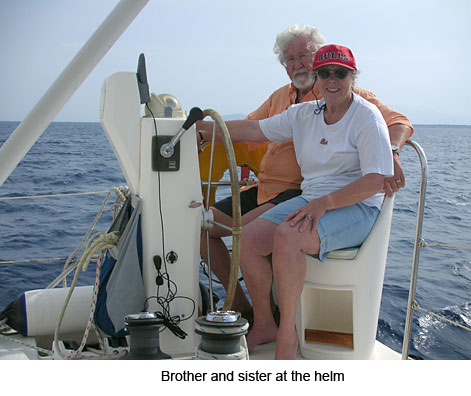 By 0930, we are sailing with a 15-18 knot south wind on the beam as we head WNW to Chios (Khios). Helga sits at the helm, wearing a smile from ear to ear. The last time she was on a sailing trip with us was on a charter in Greece 11 years ago. As we sail closer to the island, we head for the harbor behind the breakwater and I call for instructions by Port Control. It is only a tiny fishing harbor. We have managed to sail into the wrong harbor! The Greek Pilot mentions a marina-in-progress, but there are certainly no facilities here.
By 0930, we are sailing with a 15-18 knot south wind on the beam as we head WNW to Chios (Khios). Helga sits at the helm, wearing a smile from ear to ear. The last time she was on a sailing trip with us was on a charter in Greece 11 years ago. As we sail closer to the island, we head for the harbor behind the breakwater and I call for instructions by Port Control. It is only a tiny fishing harbor. We have managed to sail into the wrong harbor! The Greek Pilot mentions a marina-in-progress, but there are certainly no facilities here.
.
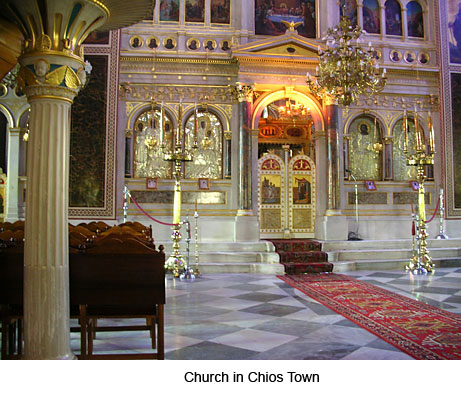 We head for the immigration quay at the town of Chios, not far away, docking against tires beyond the cruise ships. It’s a tight fit, side-tied, but three officials are there to help us. It begins to rain as we step over from our boarding ladder onto the tires and then onto the quay. Our freshly washed yacht will be a mess of black marks and streaks. There are three places to go and lots of Grecian bureaucracy, which takes up the remainder of the morning. Immigration. Port police to get our transit log started. Arrange for fuel. But the good news is that while we are back on board having lunch, the fuel tanker truck comes alongside and we fill up for the islands at a less expensive rate than in Turkey. We search for a spot as directed, finally finding one along the town quay. There is no one to help us dock, but I manage to jump off and secure the lines.
We head for the immigration quay at the town of Chios, not far away, docking against tires beyond the cruise ships. It’s a tight fit, side-tied, but three officials are there to help us. It begins to rain as we step over from our boarding ladder onto the tires and then onto the quay. Our freshly washed yacht will be a mess of black marks and streaks. There are three places to go and lots of Grecian bureaucracy, which takes up the remainder of the morning. Immigration. Port police to get our transit log started. Arrange for fuel. But the good news is that while we are back on board having lunch, the fuel tanker truck comes alongside and we fill up for the islands at a less expensive rate than in Turkey. We search for a spot as directed, finally finding one along the town quay. There is no one to help us dock, but I manage to jump off and secure the lines.
We are dead tired, but a siesta is not possible with the cycles revving and the four lanes of traffic along 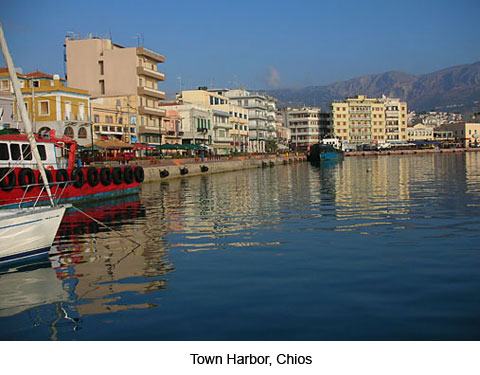 screaming along the busy street right off the quay. We decide that we will blow this place in the morning to head for the south side. The castle is not open for touring and it is obvious that this is not a tourist town. In the afternoon, Gunter and Helga walk all the way back to immigration to check out. “You can only check out on the day you actually leave; you must come back tomorrow,” was the answer. This news is upsetting, because this will be the bureaucratic norm for all of Greece. We will have to check in at every port. On top of that, the bank would not change Turkish liras to euros.
screaming along the busy street right off the quay. We decide that we will blow this place in the morning to head for the south side. The castle is not open for touring and it is obvious that this is not a tourist town. In the afternoon, Gunter and Helga walk all the way back to immigration to check out. “You can only check out on the day you actually leave; you must come back tomorrow,” was the answer. This news is upsetting, because this will be the bureaucratic norm for all of Greece. We will have to check in at every port. On top of that, the bank would not change Turkish liras to euros.
“Why not? I ask Gunter.
“Don’t know. They said they do not do so in all of Greece.” I hadn’t realized that the Turkish-Greek relationship is still that poor.
After the rush hour traffic subsides, the town is not so bad. We cannot find a café away from the noisy quay, but during our search into the side streets, we do discover a wonderful old church being renovated. The cross on top of the majestic old structure reminds us that, after so long in Muslim countries, we are finally back in a Christian land. We find a pew inside to pray and peace returns to our souls. The interior is richly adorned with sculptures, paintings and portraits in vivid primary colors.
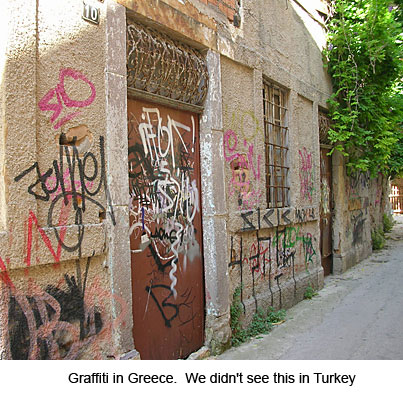 Eventually, we return to a café that sports a second level overlooking the harbor and street below. We order zucchini balls and pork casserole. The after-dinner drink on this island is called mastikha, a bitter-sweet liquor made from the aromatic resin of the mastic or lentisk tree. A few tastes were all I needed; I do not care for sweet liquors.
Eventually, we return to a café that sports a second level overlooking the harbor and street below. We order zucchini balls and pork casserole. The after-dinner drink on this island is called mastikha, a bitter-sweet liquor made from the aromatic resin of the mastic or lentisk tree. A few tastes were all I needed; I do not care for sweet liquors.
The nickname for Chios is “fragrant island” due to the mastic tree. A resin obtained from the punctured stems is used in medicines and varnishes. Mastic has been used in classical times as a chewing gum, said to preserve the gums and to freshen the breath. The Arabs produced oil from the berries, used for food as well as for illumination. It is also used in a sickly sweet confection and in a sweat meat called “mastiche.” The Sultan’s ladies also believed it to be an aphrodisiac, but I didn’t notice any effects when Gunter came to bed, other than louder-than-usual snoring!
June 7: Sailing to South Chios
It turns out that two cruise ships are exiting the harbor early this morning and the harbor wants us to leave after 0900. So after Gunter and Helga walk once again around the bay to the harbor police, we have a nice breakfast on board with fresh pastries filled with spinach and cheese. We are groggy from lack of sleep. The disco played loud raucous music until 5 AM, and we had only two hours of peace after that before the rush hour traffic began. At least there were no muezzin calls!
By 0955, we are already exiting the harbor of Chios, bound for Ormos Kamari, a small fishing anchorage. We drone south along the coast in a breeze too light to sail.
Along the way, I catch up on the island’s history. Many islands claim to be the birthplace of Homer, but Chios is the most likely. He calls it craggy, and deservedly so. A high rocky ridge runs along its spine from Mt. Profitus at 4,255 feet in the north to low-lying Ak Mastikho in the south, which appears as a lunar landscape of parched and pitted rock as we motor along its eastern shore.
Ancient descriptions praise the island’s fertility, but only on the northwest coast and in the fertile plains to the south is there any resemblance. The ancient history is illustrious, but that is overshadowed by contemporary tragedy.
Along with Samos and Smyrna (Izmir), Chios became part of the Ionic Confederacy and enjoyed a period of affluence in which the arts prospered. Homer, “that blind man of rocky Khios,” Thales of Miletus, and later the tragic poet Ion were of that era. Then the Romans sacked it and it sank into obscurity, invaded by the Saracens and becoming a pirate stronghold. A Genoese family took control in the early 14th century and the island became prosperous again.
The Turks took Chios in 1566, occupying it until 1972. And here the sad story of this island begins. The Greek War of Independence began in 1821. In 1822, the Khians joined the revolt. Chios had been under a special regime with the Ottoman Empire as the sole source of mastic. It brought a personal source of tax revenue to the sultana, the mother of the occasional sultan. So here, the rule of the Turks was much more lax. “The Samiots (from Samos) forced the Khians to rebel,” says an article I am reading in the This week in history section of the Athens News. “Original successes turned into a rout and when a Turkish fleet of 47 ships and 7,000 men arrived, the rout became a slaughter.” It was a terrible revenge that reverberated around the world. “The towns on Khios were razed, 25,000 Khians were massacred and 47,000enslaved,” reports the Pilot. The News goes on to say, “The Turks estimated 50,000 killed (based on an account of severed tongues and ears) and about 52,000 enslaved.” Considering how rocky and barren most of this island appears, we on board doubt that it could have supported a population of 100,000. At any rate, the artist Delacroix commemorated the event and Victor Hugo wrote A Child of Khios.
The newspaper goes on to recount the revenge of Admiral Kanaris when he destroyed the Turkish flagship on June 6th of that year. It was a bittersweet feat, since a large number of enslaved women were on that ship. All women over 40 had been killed, the rest enslaved. Those Khians who did manage to escape were scattered all over Europe. Many became prosperous merchants and ship owners.
As if that massacre weren’t bad enough, Khios had barely recovered when a massive earthquake shattered the island in 1881, killing 3,500.
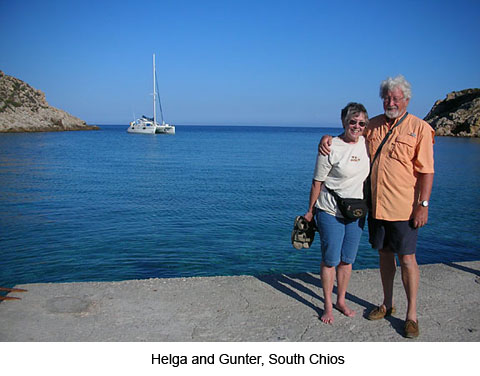 The entrance to the small cove of Ormos Kamari is impressive, with steep cliffs on either side. Through our binoculars, I see bathers on a sloped beach of black volcanic sand. As we motor past and behind the cliffs, we spot a natural, little harbor. No other yachts are anchored there. It turns out to be a 3x anchor dance, lots of practice for Helga, because we want lot of swing room and the harbor is tiny. Finally, our Delta is buried firmly in sand and we have plenty of room if the fickle Mediterranean wind should choose to change direction. Later, another yacht enters the harbor, asks where our anchor is, and leaves. We are all alone, except for a few fishing boats that take up small moorings near shore. We swim, take naps, and later launch Petit Bliss to explore the little settlement.
The entrance to the small cove of Ormos Kamari is impressive, with steep cliffs on either side. Through our binoculars, I see bathers on a sloped beach of black volcanic sand. As we motor past and behind the cliffs, we spot a natural, little harbor. No other yachts are anchored there. It turns out to be a 3x anchor dance, lots of practice for Helga, because we want lot of swing room and the harbor is tiny. Finally, our Delta is buried firmly in sand and we have plenty of room if the fickle Mediterranean wind should choose to change direction. Later, another yacht enters the harbor, asks where our anchor is, and leaves. We are all alone, except for a few fishing boats that take up small moorings near shore. We swim, take naps, and later launch Petit Bliss to explore the little settlement.
The love of flowers is evident, with fragrant oleander, trumpet flowers, and vines creeping up the sides of old and modern housing, side by side. The houses are white, with blue panes and doors. The pace is relaxed and very slow. There are three small restaurants, a convenience store, and not much else other than a road leading back to Chios Town. I order the last “sea bream special” at Neptune Restaurant; Gunter orders grilled sardines and Helga orders a cod steak. We share a Greek feta cheese salad and the vegetable casserole that comes with my special, enjoying an excellent a view of Pacific Bliss gracefully bobbing at anchor. Back on board, Gunter and Helga have a mastikha absacker. We head into a calm night—no muezzin, no music, just the gentle slapping of the waves and a few fishing boats coming in at dark.
June 8: Sunday Sail to Icaria
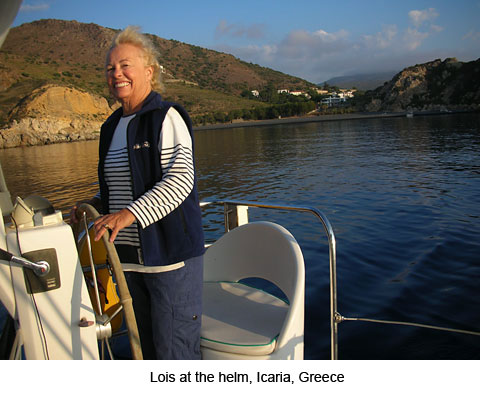 I am not a happy camper as I sit on watch at the helm seat, being jerked about. Our forecast was for a 3-6 South during the day, with a meltemi beginning tomorrow. But these forecasts in the Med are as undependable as they can be! We are experiencing SE winds F4-F6 today, and guess which way we are headed towards Icaria? Southeast, of course. I’m reminded of the prevailing winds in Turkey as we sailed the coast NW from Marmaris, always on the nose as we followed the coast to Cesme. I even don my sailing vest! We thought that the 44-mile passage from Chios to Icaria would make a wonderful day sail. Think again.
I am not a happy camper as I sit on watch at the helm seat, being jerked about. Our forecast was for a 3-6 South during the day, with a meltemi beginning tomorrow. But these forecasts in the Med are as undependable as they can be! We are experiencing SE winds F4-F6 today, and guess which way we are headed towards Icaria? Southeast, of course. I’m reminded of the prevailing winds in Turkey as we sailed the coast NW from Marmaris, always on the nose as we followed the coast to Cesme. I even don my sailing vest! We thought that the 44-mile passage from Chios to Icaria would make a wonderful day sail. Think again.
By afternoon, the wind lessens to a steady F4 which continues until the little harbor of Icaria comes into view. There are two breakwaters, an outer one for ferries, and an inner one for yachts. The “finger piers” referred to in the Pilot are small; one is empty except for a med-moored pleasure boat. We side-tie without a problem. Then we walk through the little village of Avios Kirikos (Agios Kirykos), the capital and the ferry port on the southeast side of Nisos Ikaria (Nicaria). We find a little café where Helga and I enjoy iced coffees and ice cream while Gunter heads for the port captain, checking in and out for 14 euros. Back on Bliss, passersby stop to admire our boat that dominates the harbor, the only cruising yacht here.
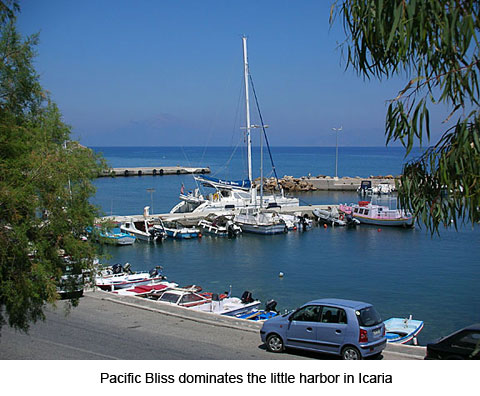 The island of Ikaria is a precipitous slab of rock wedged into the sea west of Samos. It has green wooded and cultivated valleys to the north, according to an American-Greek couple we meet, searching out their “roots.” They took a blood-curdling drive over the spine. “There are no guard rails there, nothing, they informed us.” After our sail, we don’t even have the ambition to climb the hill to the blue-domed church high over the town, even though it probably has a magnificent harbor view.
The island of Ikaria is a precipitous slab of rock wedged into the sea west of Samos. It has green wooded and cultivated valleys to the north, according to an American-Greek couple we meet, searching out their “roots.” They took a blood-curdling drive over the spine. “There are no guard rails there, nothing, they informed us.” After our sail, we don’t even have the ambition to climb the hill to the blue-domed church high over the town, even though it probably has a magnificent harbor view.
“The name Ikaria is probably derived from the Phoenician word “ikor” meaning an abundance of fish,” says our Pilot. And alternative and mythical origin of the name is derived from the legend of Daedallus and Icarus who contrived to escape from Crete by fabricating wings from feathers and wax so that he fell into the sea near Ikaria. The Pilot goes on to describe the port: “The town is an attractive straggle of buildings up steep slopes from the harbor and the locals are friendly. The only problem is the meltemi which howls off the slopes and makes getting around the island a nightmare at times. Personally, I think Icarus had his feathers blown off around here by the meltemi and didn’t get anywhere near the sun.”
After siestas, Gunter and Helga clean the black marks off the side of the hull and the fenders left from our side-tie at the Chios immigration dock. We do have water, but no electricity, since it is a Sunday and the meter has not been turned on. As the sun sets, we enjoy a deluxe feta cheese salad in the cockpit, a gentle breeze wafting over the harbor. Then we all enjoy showers, the water still warm from all that motoring.
In the coolness of the evening, we walk the town, and even tackle the hill to the church, which is closed. Back on the bay, we end up at an outdoor café, where a flat panel TV has been installed, and watch the Germany-Poland World Cup soccer match.
June 9: Sailing to Mykonos
We motored this morning along the coast of Ikarias on glassy seas, marveling at the rugged mountainous coastlines, watching how the dangerous dirt road winds around to small villages clinging to the mountainside. Most of the small villages have little churches. How isolated these people must feel! But they probably live here only in the summertime.
And now we are sailing. We are sailing! Full main and jib. Swishing along at 8 knots. Autopilot set to “sailing by the wind.” The wind is Force 4, NNW. Perfect.
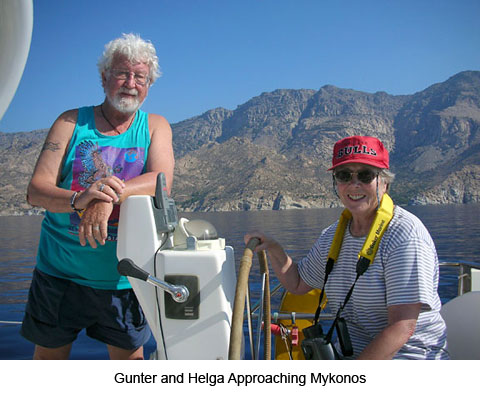
June 11: Mix-up in Mykonos
The primary form of cruising entertainment, as many of you know, is called “The Anchor Dance.” As a cruiser successfully completes his own anchoring, there are high-fives all around as the Captain praises the crew—or in some cases, discusses what went wrong and how the procedure can be improved the next time. Then the crew sits around the cockpit with an arrival beer, basking in the joy of mission accomplished. Whenever a new yacht arrives, everyone watches it anchor. In the case of the small harbors in the Med, “the anchor dance” is med-mooring. The yacht cruises around to find a place, then drops the anchor in the middle of the basin, far ahead of its selected space, then backs stern to against the sea wall, dock, or quay. In a small harbor with the meltemi (north wind) blowing, this activity can be more exciting than watching the Summer Olympics.
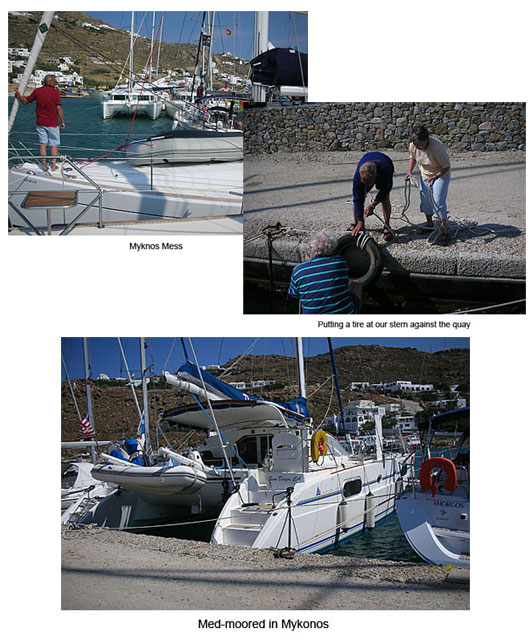
But yesterday afternoon here in the “Mykonos Marina,” a concrete hole without facilities where the rich touristy town shunted off the cruising yachts, “the anchor dance” came too close for comfort because it threatened Pacific Bliss.
A twelve meter charter yacht with a Czech crew of five (the skipper, three men and one woman) entered our narrow harbor, cruising slowly along the center, looking for a space. On its starboard, cruising yachts are not allowed; to its port was our line-up of yachts; those who are side-tied are rafted two deep; those who are med-moored, like us, have their anchors far out toward the center, allowing plenty of scope in preparation for the strong meltemi forecast with small craft advisories.
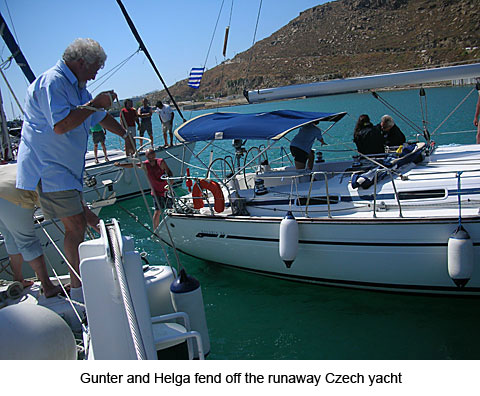 The yacht cruised back and forth for about half an hour, coming dangerously close to anchor lines, with all the Captains lined up on the bows of their sailing vessels yelling advice such as: “Stay away. Don’t come closer! My anchor is right there.”
The yacht cruised back and forth for about half an hour, coming dangerously close to anchor lines, with all the Captains lined up on the bows of their sailing vessels yelling advice such as: “Stay away. Don’t come closer! My anchor is right there.”
But the meltemi was already gusting over 20 knots, scrunching the yachts up tight against the rough-cut concrete quay. The only prevention against the yachts bashing up their sterns was their anchors; some had two arranged diagonally from their single bow. We had one anchor set at an angle, in deference to the nice German Captain of the 50-foot Jeanneau, snug tight to our starboard. It is a Grecian-flagged charter; he is currently is the only person on board. The anchoring set-up worried Gunter, because the pull would not be straight, but thank God, we dutifully arranged our usual bridle anyway. We were fortunate to have another nice neighbor, a German-flagged Bavarian 38, with a couple on board, to our port.
During one of their passes, the meltemi gusted and swept the Czech yacht onto our port neighbor’s anchor. That stopped the yacht; it broached sideways into the wind, now across the bows of our three yachts. The crews on all three boats—the couple to our port, the single sailor to our starboard, and Helga, Gunter and I—all ran for our fenders and pushed with all our might to fend off the encroaching yacht. Six strong men on 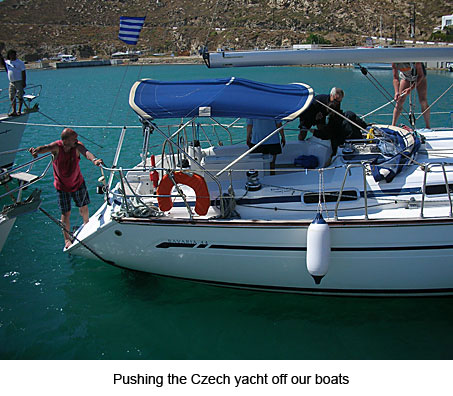 another unthreatened charter boat next to our port neighbor stood on their bow and just simply watched the action—not helping at all.
another unthreatened charter boat next to our port neighbor stood on their bow and just simply watched the action—not helping at all.
“Come over here,” Gunter yelled to them. “Help us fend off!” Either they didn’t want to help, didn’t understand English, or were just wet behind the ears.
“If there were cruisers here instead of charterers,” grumbled Gunter, “our three boats would be covered with men by now, all working together and knowing what to do.”
This anchor dance went on for at least an hour. Every time the Czechs would get free of one anchor, they drifted on to another. At one point, their yacht’s keel was stuck in our port neighbor’s chain. An American skipper from one of the side-tied yachts had his dinghy out and came to the Czech’s aid to help get the chain out from underneath. Then they drifted onto our anchor chain. It yanked at the bridle with incredible force; if not for that bridle set-up, I’m sure it would have wrecked our windlass. I feared that either our black line or our anchor chain would break, causing a royal mess.
“Bring it up…no, let it down...” the three Captains yelled out conflicting instructions over the howl of the meltemi to the confused Czech at the bow of the drifting yacht. He either let out all of chain he had or jammed his windlass bringing it up…whatever. At any rate, then he was really out of control, and his anchor chain grabbed onto that of the Jeanneau to our starboard. The jammed windlass somehow got fixed; the American skipper with the dingy gained some authority, giving out instructions in a calm manner, and managed to push the yacht free and back out into the center of the basin. The yacht began to motor along, searching for a spot… “Go, get out of here!” yelled a Captain (not ours). The yacht turned and slowly motored out of the harbor. We suspect that he moored out onto the other side of the breakwater, where there is more room, although we don’t know if yachts “are allowed” there!
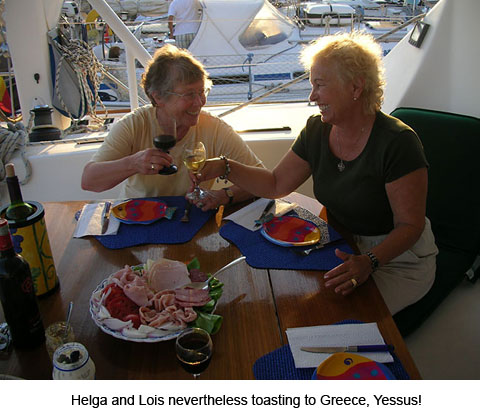 We settled into a nice sundowner on board, trying to ignore our view of the ugly quay and the huge cruise ship that just pulled in, knowing that the rich island of Mykonos caters to them, while the yachties are confined to the concrete hole. European harbors. Bah humbug! It has been a long day. It is time to enjoy ourselves.
We settled into a nice sundowner on board, trying to ignore our view of the ugly quay and the huge cruise ship that just pulled in, knowing that the rich island of Mykonos caters to them, while the yachties are confined to the concrete hole. European harbors. Bah humbug! It has been a long day. It is time to enjoy ourselves.
Insert photo 16 Sundowner Helga and Lois toasting
Insert photo 17 European harbors, bah humbug!
Insert photo 18 Cruise ships dominate, yachts are in a concrete hole.
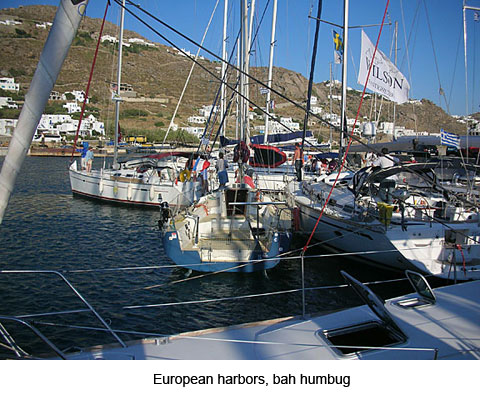
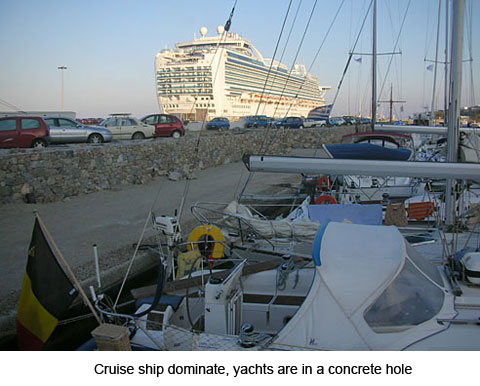
June 12: The Anchor Dance Continues.
 Yes, would you believe that getting “outta Dodge” was as traumatic as the first anchor dance? I think Gunter had a premonition. He had trouble sleeping, even after he had carefully gone over the minute details of how we would handle our departure. And in morning, he was tramping all around the deck, which woke us up, before he even had his coffee! So we were ready to leave an hour before our next door neighbors (whom we needed and trusted after the Czech episode) had their breakfast. (We had croissants and rolls from the bakery in Mykonos). By the way, the morning after that anchor dance, with no wind, the Czech boat slipped quietly into the Mykonos harbor, replacing the boat that had left (on the other side of our port neighbor). Gunter and our two neighbors graciously helped them, catching their lines at the quay.
Yes, would you believe that getting “outta Dodge” was as traumatic as the first anchor dance? I think Gunter had a premonition. He had trouble sleeping, even after he had carefully gone over the minute details of how we would handle our departure. And in morning, he was tramping all around the deck, which woke us up, before he even had his coffee! So we were ready to leave an hour before our next door neighbors (whom we needed and trusted after the Czech episode) had their breakfast. (We had croissants and rolls from the bakery in Mykonos). By the way, the morning after that anchor dance, with no wind, the Czech boat slipped quietly into the Mykonos harbor, replacing the boat that had left (on the other side of our port neighbor). Gunter and our two neighbors graciously helped them, catching their lines at the quay.
So by 0845, our engines were running and our neighbors were at the quay ready to assist us. They helped Helga untie and release our white line from the two tires we had commandeered, which we left back on the quay for the next hapless cruiser who might be deceived by news of the “new port” near Mykonos. We brought in all of the spring lines and stern lines, and I began to pull in the long anchor chain in (which, if you will remember, was diagonal to our port bow). It only came up so far, then the windlass couldn’t take it, screeching in pain. I thought it was jammed, but Gunter had foreseen the coming calamity.
“The Czech boat, the last to come in, their anchor is over ours!” he shouted from the helm. “Let some more chain down.” Down…up. Down…up. Gunter moved forward each time I pulled the chain upwards. Thank God, there was not a meltemi pushing us back towards the ugly quay! All the captains were on their bows. The entire crew of the Czech boat crowded onto their bow, looking dumfounded.
“I cannot pull up any more chain,” I yelled back to Gunter and the audience on their yachts.
“Let out your anchor line,” Gunter commanded the Czech boat. At first they just stood there, for which seemed like an interminably long time to me, struggling with the pull of another chain over ours. I feared either our chain or windlass would break and agonized over which would happen first and how we would deal with it.
Then they let out more chain and I managed to pull some more of ours up. But then the windlass screamed and slipped again. I could see their anchor now, grabbing tightly onto our chain, right at the water line. I called to shore for a dinghy to help to take the anchor off. But that was a mistake, a crew calling the commands. There can be only one Captain of a ship. Gunter came up to the bow with the boat hook. “You take the helm.”
As I went back, Pacific Bliss drifted back in front of Eberhard’s Jeanneau. “Forward, forward yelled the German Captain. He feared a repeat of yesterday’s drama. Gunter bent as far down as he could over the bow with the boat hook as Helga held onto his legs. But he couldn’t free it and let out more chain. Then somehow, as I steered forward, the errant anchor disentangled, and Gunter pulled in the chain. “Keep going, we are free!” he shouted. There were cheers and waves on the bows of the yachts as we waved good-by. Gunter took back the helm, and we motored slowly out of the hellhole of the Mykonos “new port,” one that I never want to see again. A recommendation to other cruisers: Don’t go there! We have heard that sailing yachts can anchor about two miles in a bay on the south side of Mykonos. From the “new port,” it is two miles into the town anyway, and one cannot walk the dangerous curvy stretch of highway, with no provisions for pedestrians.
We did go into the town twice, catching a ride from our newfound friend, Eberhard, and taking a taxi back. The population of Mykonos town is only 4,000 or so, but when the huge cruise ships disgorge their passengers, it can swell to more then 10,000. We managed to find some off-the-beaten-path restaurants on the side streets away from the seashore. And the maritime museum had a charming courtyard in back to get away from it all. The town’s building code requires all buildings to maintain the white rounded architectural style with blue trim, which makes it picture postcard perfect. The pictures in the Photogallery below tell the story:
________________________________________________________________________
We motorsail in light winds to Siros arriving in the afternoon and heading for Finikas southwestern side, well away from the dirty harbor capital city to the east. This spot was recommended to us by Eberhard, our neighbor in the Mykonos “new port.” After that dirty hole, we wanted to sail to a nice place and now we have our wish.
“We don’t want to leave here so soon,” says Gunter.
We have no problems with med-mooring this time. I drop our anchor 60 feet straight ahead of Bliss. Gunter—at the helm—backs to within 10’ of the quay. Helga throws the port stern line to another sailor waiting on the quay; I cleat off the starboard, then head back to the bow to pull the anchor tight so that we can use our passerelle (gangplank) to walk right onto the quay. In a light F2 breeze, we handle it all like Med professionals! Not bad for three “mature” sailors!
We on the sea-side of a nice clean quay with water and electricity and even toilets at the end. There are even showers (9-12 AM only, when the harbormaster is on duty) but from what we’ve experienced so far in Greece, this is an amazing improvement. The water is crystal clean; in fact, we can swim in front of Pacific Bliss, then dry off on the trampoline and get a swim suit tan. We plan on doing that tomorrow. The water has warmed now in the Med; it is 65 ºC. The air has also warmed; it is only 10:30 AM, and the air temp is already 26ºC (82 F). Time for those sun-tops!
After settling in here, we have a nice dinner at the Acapulco Taverna on shore, overlooking the yacht harbor. We watch the Germany/Croatia soccer game on the flat screen TV. Too bad, Germany loses 2 to 1.
Walking back along the dock, we reacquaint ourselves with another cruiser, Clementine, a veteran of last year’s Thailand-to-Turkey voyage. They had arrived in Turkey also in June of 2007, but this plucky Australian family lives on their boat, so they spent the summer sailing the Med and wintered in Turkey. They are on to Spain, Gibraltar, and crossing the Atlantic to the Caribbean yet this year—a long cruising path ahead of them.
Friday, June 13, 2008: The Sacrifice of the Fat Boy
Friday the 13th, a good day to stay in port, but we are safe here, or so we thought.
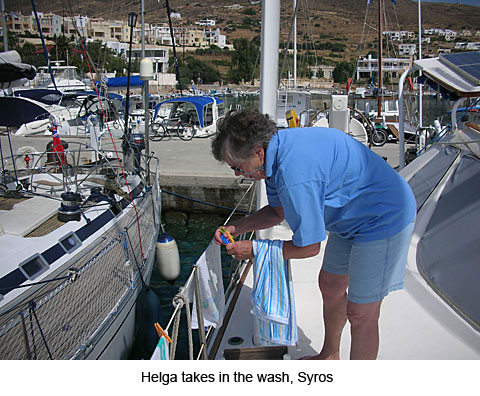 In the morning, Helga and Gunter wash down the exterior of the boat. I sit in the starboard hull at my computer desk, writing. I have the third load of clothes and towels in our faithful little washing machine on board, having hung the first two loads, despite the tendonitis in my right arm, which is finally getting better but not healed, and my new injury, a strained lower left back—probably obtained during the latest Mykonos Mess.
In the morning, Helga and Gunter wash down the exterior of the boat. I sit in the starboard hull at my computer desk, writing. I have the third load of clothes and towels in our faithful little washing machine on board, having hung the first two loads, despite the tendonitis in my right arm, which is finally getting better but not healed, and my new injury, a strained lower left back—probably obtained during the latest Mykonos Mess.
To think that the harbor was so nice when we arrived here yesterday and med-moored handily, stern against the quay. Magical crystal water. Barely a breeze. Gunter checked the anchor, lodged into white sand, and raved about the spot. We would spend our “free day” here, just taking it easy.
By afternoon today though, the warm southerly increases steadily. The quay has filled with yachts of all types—a catamaran, private “stink potters” (motorboats) and an assortment of monohulls. Our Aussie friends on Clementine are two boats down, their “baby girl” in the Darwin-to-Kupang Rally now three years old. Between our boats is the monohull KeriKeri, carrying a New Zealand family of six.
The Siros Moorings Yacht Charters has a base at the harbor, and their yachts are coming in to take refuge from the whitecaps farther out to sea. They are being directed inside the breakwater. Although there has been no room for us in the calm waters inside, the dark mop-haired Greek charter manager is occupied with rafting all the Moorings yachts together, two and three deep.
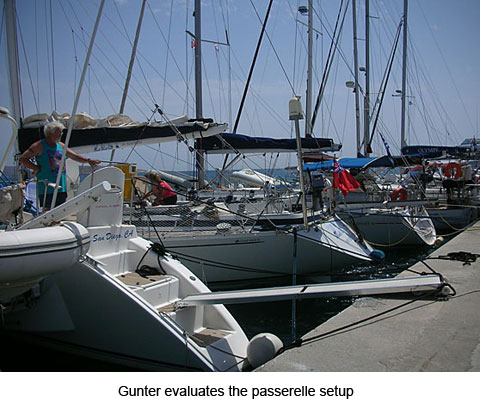 “You’d be better off leaving the quay,” the manager advises as he briskly swings his shoulder-length hair and busies himself with the next charter boat. The group of private yacht captains nod and stay put, while they added more fenders to their sterns, set up additional spring lines, and tighten up their boarding ladders and passerelles to prevent them from slamming up and down on the quay with each roller. After all, how bad a blow could a southerly be? The meltemi are supposed to be the dangerous Med winds.
“You’d be better off leaving the quay,” the manager advises as he briskly swings his shoulder-length hair and busies himself with the next charter boat. The group of private yacht captains nod and stay put, while they added more fenders to their sterns, set up additional spring lines, and tighten up their boarding ladders and passerelles to prevent them from slamming up and down on the quay with each roller. After all, how bad a blow could a southerly be? The meltemi are supposed to be the dangerous Med winds.
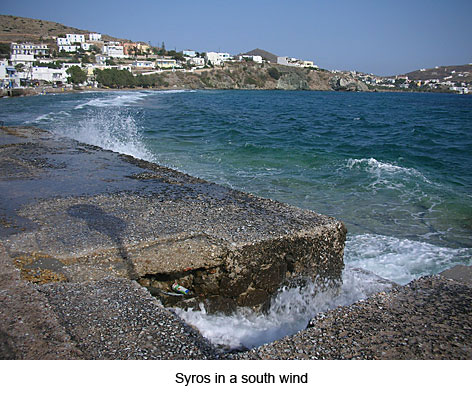 Helga and I head to the “internet” to see what www.WindGuru.com has in its forecast for the area. There is supposedly an internet service in the marine chandlery in town. The sign says “Back Soon.” We hang around for an hour. Just as we are ready to leave, a frumpy little woman whom I assume is the proprietor finally shows up. For two euros an hour, we are directed to use her laptop in a dark little room off a two-room store, piled with inventory—chains, lines, oil, sandpaper, paint, etc. Her mouse is not working, and the instructions are in MS, Greek version. She has zero computer knowledge to help me. We manage to get a forecast, anyway. The blow will last until midnight, the highest at 17 knots. That doesn’t seem so bad.
Helga and I head to the “internet” to see what www.WindGuru.com has in its forecast for the area. There is supposedly an internet service in the marine chandlery in town. The sign says “Back Soon.” We hang around for an hour. Just as we are ready to leave, a frumpy little woman whom I assume is the proprietor finally shows up. For two euros an hour, we are directed to use her laptop in a dark little room off a two-room store, piled with inventory—chains, lines, oil, sandpaper, paint, etc. Her mouse is not working, and the instructions are in MS, Greek version. She has zero computer knowledge to help me. We manage to get a forecast, anyway. The blow will last until midnight, the highest at 17 knots. That doesn’t seem so bad.
As we walk along the quay to Pacific Bliss, all the captains sit glumly in their cockpits, “endurance” etched upon their faces, as their yachts toss and roll as if they are tumbling in a washing machine.
Gunter is struggling with our passerelle, the fender underneath it escaping as it bounces off and onto the quay. Helga and I can barely step on the ramp to get back onto Bliss. Gunter had planned to take us to dinner; now we know there will be no leaving the boat this night.
Clementine is the first to “get outta Dodge.” Their anchor is not holding and as it drags, the incoming waves slap their stern hard into the quay. They take off in a mad rush and anchor across the bay, which is just far enough away that we can not tell whether it is calmer there or not. We ponder what to do. The captain of Clementine dinghies back to us. “It is a world of difference over there,” he says to Gunter from the quay. We are still debating. It would be such work to release all of our setup; and what if it is still lumpy over there and our anchor doesn’t hold? Here it we know that it is dug in deep and holding fast in sand. Gunter snorkeled out to check it yesterday.
Then a wind gust sloshes a huge breaker against the quay; the port stern Pacific Bliss veers, pushing hard on the three fenders Gunter has set up there. Pop! The Fat Boy blows. The other two fenders are squashed to thin replicas of themselves. Without our faithful Fat Boy, we are in big trouble. “We’re outta here,” cries Gunter. “Help us please,” he yells to the charter yachties who are watching on the quay. (They had been giving differing advice to him all afternoon.) One “helper” begins to release the line at the port swim ladder where the Fat Boy blew.
“No,” I yell out to him. “Only release it when the Captain says.” Gunter is starting both engines to keep Pacific Bliss away from the quay.
“Of course,” he says. “Sorry.”
The longest seconds in my life are waiting for those starboard lines and the passerelle to be taken in, guarding the port stern and fearing that it will be smacked again by another breaker. All the remaining fenders at our stern are left on as I go up to the bow to take up the anchor and Gunter guns both engines. We speed across the bay and anchor in surprisingly better conditions. It is hard to believe that we are in the same bay! By the time our anchor is set, KeriKeri has hoisted their anchor, and the other yachts have also followed to calmer waters. Except for two huge private yachts, the quay has emptied faster than a church on a hot summer day after the sermon has gone into overtime.
We methodically organize all of our docking lines and pull up the fenders that are still attached tight to our stern. The Fat Boy lies injured and looking more like a Flat Boy. Gunter takes a careful look, turning him over and finding a big slash. “He cannot be repaired; we’ll have to let him go, he announces gravely.” He tries to lift him on board to no avail. The Fat Boy is already too bloated with the water he has taken on. Gunter solemnly asks for the knife to cut off the lines, then gently lets him go. “A fitting Burial at Sea for the Fat Boy, who sacrificed himself to protect Pacific Bliss.”
I bless Fat Boy as he swivels around, expecting him to sink any minute. “Thanks for all your dutiful service in protecting Pacific Bliss ever since we adopted you in a Gibraltar chandlery, back near the beginning, in the year 2000. May you rest in peace.” But the Fat Boy doesn’t go down; he keeps drifting slowly around the bay, getting nearer to the Greek navy ship anchored there. I’ve been afraid that we anchored too close; in fact MaxSea shows where we are anchored as a RED zone, but we have no alternative. We need plenty of swing room.
“I hope that the Navy doesn’t think that is a sea mine,” worries Gunter.
Fat Boy gradually takes on water, as he slowly sinks to the depths of the sea. “You did good*,” I pronounce solemnly as the golden globe of sun sinks behind the mountains that are supposed to protect this harbor from the fierce meltemi. It is 0845, time for a real sundowner. We need it.
* a family saying
